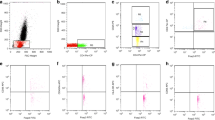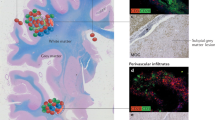Summary:
Bone marrow (BM) stem cell reserves and function and stromal cell hematopoiesis supporting capacity were evaluated in 15 patients with multiple sclerosis (MS) and 61 normal controls using flow cytometry, clonogenic assays, long-term BM cultures (LTBMCs) and enzyme-linked immunosorbent assays. MS patients displayed normal CD34+ cell numbers but a low frequency of colony-forming cells (CFCs) in both BM mononuclear and purified CD34+ cell fractions, compared to controls. Patients had increased proportions of activated BM CD3+/HLA-DR+ and CD3+/CD38+ T cells that correlated inversely with CFC numbers. Patient BM CD3+ T cells inhibited colony formation by normal CD34+ cells and patient CFC numbers increased significantly following immunomagnetic removal of T cells from BMMCs, suggesting that activated T cells may be involved in the defective clonogenic potential of hematopoietic progenitors. Patient BM stromal cells displayed normal hematopoiesis supporting capacity indicated by the CFC number in the nonadherent cell fraction of LTBMCs recharged with normal CD34+ cells. Culture supernatants displayed normal stromal derived factor-1 and stem cell factor/kit ligand but increased flt-3 ligand levels. These findings provide support for the use of autologous stem cell transplantation in MS patients. The low clonogenic potential of BM hematopoietic progenitors probably reflects the presence of activated T cells rather than an intrinsic defect.
This is a preview of subscription content, access via your institution
Access options
Subscribe to this journal
Receive 12 print issues and online access
$259.00 per year
only $21.58 per issue
Buy this article
- Purchase on Springer Link
- Instant access to full article PDF
Prices may be subject to local taxes which are calculated during checkout







Similar content being viewed by others
References
Marmont AM . Stem cell transplantation for severe autoimmune diseases: progress and problems. Haematologica 1998; 83: 733–743.
Ikehara S . Bone marrow transplantation for autoimmune diseases. Acta Haematol 1998; 99: 116–132.
Burt RK, Traynor A . Hematopoietic stem cell therapy of autoimmune diseases. Curr Opin Hematol 1998; 5: 472–477.
Burt RK, Marmont AM . Stem Cell Therapy for Autoimmune Disease. Landes Bioscience: Georgetown, TX, USA.
Tyndall A, Koike T . High-dose immunoablative therapy with hematopoietic stem cell support in the treatment of severe autoimmune disease: current status and future direction. Intern Med 2002; 41: 608–612.
Guillaume T, Rubinstein DB, Symann M . Immune reconstitution and immunotherapy after autologous hematopoietic stem cell transplantation. Blood 1998; 92: 1471–1490.
Papadaki HA, Kritikos HD, Gemetzi C et al. Bone marrow progenitor cell reserve and function and stromal cell function are defective in rheumatoid arthritis: evidence for a tumor necrosis factor alpha-mediated effect. Blood 2002; 99: 1610–1619.
Papadaki HA, Kritikos HD, Valatas V et al. Anemia of chronic disease in rheumatoid arthritis is associated with increased apoptosis of bone marrow erythroid cells: improvement following anti-tumor necrosis factor-alpha antibody therapy. Blood 2002; 100: 474–482.
Papadaki HA, Boumpas DT, Gibson FM et al. Increased apoptosis of bone marrow CD34+ cells and impaired function of bone marrow stromal cells in patients with systemic lupus erythematosus. Br J Haematol 2001; 115: 167–174.
Otsuka T, Okamura S, Harada M et al. Multipotent hemopoietic progenitor cells in patients with systemic lupus erythematosus. J Rheumatol 1998; 15: 1085–1090.
Snowden JA, Nink V, Cooley M et al. Composition and function of peripheral blood stem and progenitor cell harvests from patients with severe active rheumatoid arthritis. Br J Haematol 1998; 103: 601–609.
Burt RK, Fassas A, Snowden J et al. Collection of hematopoietic stem cells from patients with autoimmune diseases. Bone Marrow Transplant 2001; 28: 1–12.
Shaughnessy PJ, Ririe DW, Ornstein DL et al. Graft failure in a patient with systemic lupus erythematosus (SLE) treated with high-dose immunosuppression and autologous stem cell rescue. Bone Marrow Transplant 2001; 27: 221–224.
Papadaki HA, Gibson FM, Rizzo S et al. Assessment of bone marrow stem cell reserve and function and stromal cell function in patients with autoimmune cytopenias. Blood 2000; 96: 3272–3275.
Zhou D, Hemmer B . Specificity and degeneracy: T cell recognition in CNS autoimmunity. Mol Immunol 2004; 40: 1057–1061.
Hafler DA . Multiple sclerosis. J Clin Invest 2004; 113: 788–794.
van Bekkum DW . Stem cell transplantation in experimental models of autoimmune disease. J Clin Immunol 2000; 20: 10–16.
Burt RK, Burns W, Hess A . Bone marrow transplantation for multiple sclerosis. Bone Marrow Transplant 1995; 16: 1–6.
Fassas A, Anagnostopoulos A, Kazis A et al. Peripheral blood stem cell transplantation in the treatment of progressive multiple sclerosis: first results of a pilot study. Bone Marrow Transplant 1997; 20: 631–638.
Fassas A, Anagnostopoulos A, Kazis A et al. Autologous stem cell transplantation in progressive multiple sclerosis -an interim analysis of efficacy. J Clin Immunol 2000; 20: 24–30.
Fassas A, Kimiskidis VK . Stem cell transplantation for multiple sclerosis: what is the evidence? Blood Rev 2003; 17: 233–240.
McDonald WI, Compston A, Edan G et al. Recommended diagnostic criteria for multiple sclerosis: guidelines from the International Panel on the diagnosis of multiple sclerosis. Ann Neurol 2001; 50: 121–127.
Thompson AJ, Montalban X, Barkhof F et al. Diagnostic criteria for primary progressive multiple sclerosis: a position paper. Ann Neurol 2000; 47: 831–835.
Papadaki HA, Stamatopoulos K, Damianaki A et al. Activated T-lymphocytes with myelosuppressive properties in patients with chronic idiopathic neutropenia. Br J Haematol 2005; 128: 863–876.
Coutinho LH, Gilleece MH, De Wynter EA et al. Clonal and long-term cultures using human bone marrow. In: Testa NG, Molineux G (eds). Haemopoiesis. A Practical Approach. Oxford University Press: Oxford, 1993, pp 75–106.
Maciejewski J, Selleri C, Anderson S, Young NS . Fas antigen expression on CD34+ human marrow cells is induced by interferon gamma and tumor necrosis factor alpha and potentiates cytokine-mediated hematopoietic suppression in vitro. Blood 1995; 85: 3183–3190.
Maciejewski JP, Selleri C, Sato T et al. Increased expression of Fas antigen on bone marrow CD34+ cells of patients with aplastic anaemia. Br J Haematol 1995; 91: 245–252.
Zoumbos NC, Djeu JY, Young NS . Interferon is the suppressor of hematopoiesis generated by stimulated lymphocytes in vitro. J Immunol 1984; 133: 769–774.
Lapidot T, Petit I . Current understanding of stem cell mobilization: the roles of chemokines, proteolytic enzymes, adhesion molecules, cytokines, and stromal cells. Exp Hematol 2002; 30: 973–981.
Kojima S, Matsuyama T, Kodera Y . Plasma levels and production of soluble stem cell factor by marrow stromal cells in patients with aplastic anaemia. Br J Haematol 1997; 99: 440–446.
Pfister O, Chklovskaia E, Jansen W et al. Chronic overexpression of membrane-bound flt3 ligand by T-lymphocytes in severe aplastic anaemia. Br J Haematol 2000; 109: 211–220.
Fassas A, Kimiskidis VK . Autologous hemopoietic stem cell transplantation in the treatment of multiple sclerosis: rationale and clinical experience. J Neurol Sci 2004; 223: 53–58.
Fassas A, Nash RA . Multiple Sclerosis. Bailliere's Clin Haematol 2004; 17: 247–262.
Burt RK, Cohen BA, Russell E et al. Hematopoietic stem cell transplantation for progressive multiple sclerosis: failure of a total body irradiation-based conditioning regimen to prevent disease progression in patients with high disability scores. Blood 2003; 102: 2373–2378.
Papadaki HA . Autoreactive T-lymphocytes are implicated in the pathogenesis of bone marrow failure in patients with systemic lupus erythematosus. Leuk Lymphoma 2003; 44: 1301–1307.
Khoury SJ, Guttmann CR, Orav EJ et al. Changes in activated T cells in the blood correlate with disease activity in multiple sclerosis. Arch Neurol 2000; 57: 1183–1189.
Bilinska M, Frydecka I, Podemski R et al. Expression of Fas antigen on T cell subpopulations in peripheral blood of patients with relapsing-remitting multiple sclerosis. Med Sci Monitor 2001; 7: 251–255.
Jensen J, Krakauer M, Sellebjerg F . Increased T cell expression of CD154 (CD40-ligand) in multiple sclerosis. Eur J Neurol 2001; 8: 321–328.
Carreras E, Saiz A, Marin P et al. CD34+ selected autologous peripheral blood stem cell transplantation for multiple sclerosis: report of toxicity and treatment results at one year of follow-up in 15 patients. Haematologica 2003; 88: 306–314.
Rinehart J, Keville L, Clayton S, Figueroa JA . Corticosteroids alter hematopoiesis in vitro by enhancing human monocyte secretion of granulocyte colony-stimulating factor. Exp Hematol 1997; 25: 405–412.
Clausen J, Stockschlader M, Fehse N et al. Blood-derived macrophage layers in the presence of hydrocortisone support myeloid progenitors in long-term cultures of CD34+ cord blood and bone marrow cells. Ann Hematol 2000; 79: 59–65.
Heinrich MC, Dooley DC, Freed AC et al. Constitutive expression of Steel factor gene by human stromal cells. Blood 1993; 82: 771–783.
Acknowledgements
We thank Mrs Helen Koutala for her valuable help in performing the flow cytometric acquisition of BM and PB samples in MS patients and healthy controls. This work was supported by a grant (STEMNET) of the Hellenic General Secretariat of Research and Technology.
Author information
Authors and Affiliations
Corresponding author
Rights and permissions
About this article
Cite this article
Papadaki, H., Tsagournisakis, M., Mastorodemos, V. et al. Normal bone marrow hematopoietic stem cell reserves and normal stromal cell function support the use of autologous stem cell transplantation in patients with multiple sclerosis. Bone Marrow Transplant 36, 1053–1063 (2005). https://doi.org/10.1038/sj.bmt.1705179
Received:
Accepted:
Published:
Issue Date:
DOI: https://doi.org/10.1038/sj.bmt.1705179
Keywords
This article is cited by
-
Characteristics of human adipose derived stem cells in scleroderma in comparison to sex and age matched normal controls: implications for regenerative medicine
Stem Cell Research & Therapy (2017)
-
Deregulation of vital mitotic kinase–phosphatase signaling in hematopoietic stem/progenitor compartment leads to cellular catastrophe in experimental aplastic anemia
Molecular and Cellular Biochemistry (2016)
-
Stem cell treatment for patients with autoimmune disease by systemic infusion of culture-expanded autologous adipose tissue derived mesenchymal stem cells
Journal of Translational Medicine (2011)
-
Mesenchymal stem cells in health and disease
Nature Reviews Immunology (2008)



